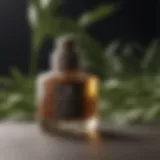Effective Solutions for Dry Calloused Heels Care
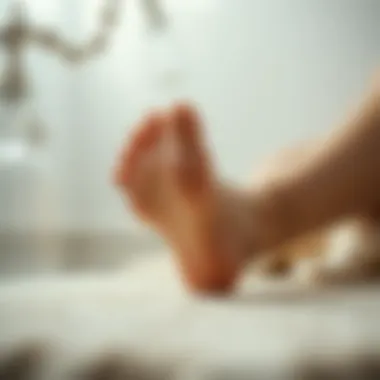

Intro
The condition of our feet can often be overlooked, yet they play a crucial role in our overall comfort and mobility. Dry, calloused heels are a prime example of this oft-neglected area. It's not just a cosmetic issue; it's a concern that, if left untreated, can lead to more severe foot problems. In this article, we will explore the culprits behind dry calloused heels, the significance of proactive foot care, and most importantly, how to care, prevent, and treat this common ailment effectively.
Understanding the importance of our feet is fundamental. For many, dry heels can cause discomfort while walking or standing, not to mention the unsightly appearance that often comes with cracked, calloused skin. The root causes often stem from external factors, like inadequate moisture, certain footwear choices, and even lifestyle habits including hydration levels. On the surface, cracked heels may seem like a minor nuisance, but the ripples of neglect can lead to pain, infections, or even structural misalignments.
In this guide, we'll break down the anatomy of the foot and delve into a range of preventative measures and treatments. We aim to arm you with knowledge to take informed steps toward achieving smoother, healthier heels.
What to Expect
As we venture through this discourse, you'll discover insights into how proper footwear can influence heel health, the significance of enlisting skincare products, and how lifestyle choices contribute to the maintenance of soft, supple heels. From home remedies to professional treatments, we will leave no stone unturned in the quest to revitalize your feet, empowering you to stride with confidence.
Understanding Dry Calloused Heels
Understanding dry calloused heels is crucial for maintaining overall foot health and comfort. Often overlooked, these pesky callouses can become a persistent problem that leads to not just discomfort, but also significant aesthetic concerns. By grasping the nature of callouses, their causes, and the impact they have on one’s heels, individuals can take strides towards healthier feet.
Notably, the skin on our heels can be less forgiving when it comes to environmental and internal stressors. Elevated levels of dryness may make the heels more susceptible to cracking, which can lead to more severe complications if left unattended. Essentially, getting a handle on what creates these callouses can empower individuals to make informed choices about their foot care routines.
Anatomy of the Heel
The heel is primarily a collection of fat pads, ligaments, and skin. The main structure is the calcaneus, or heel bone, which helps absorb impact when walking. Covering this bone is a layer of thick skin, which helps protect the underlying tissues. This thick skin forms callouses as a response to repeated friction or pressure, making it imperative to comprehend how it all works.
These anatomical elements play a pivotal role in how comfortable or uncomfortable one feels while standing or walking. Understanding this can aid in choosing effective prevention and treatment strategies. Regular and thoughtful heel care helps to promote skin elasticity and metabolism in that area, contributing to the prevention of problematic dry callouses.
Common Causes of Dry Callouses
Environmental Factors
The environmental conditions we expose our feet to can greatly influence heel health. For instance, extreme weather can dry out skin quickly, making it more prone to callouses. While some people may revel in the sunshine, prolonged exposure can deplete moisture levels in the skin.
Additionally, certain climate conditions, such as dry air and low humidity, seem to exacerbate this issue. It is important to note how seasonal changes can affect foot skin and callosity.
- Key Characteristic: Variability in environmental conditions can lead to significant shifts in skin health.
- Unique Feature: Adaptation to weather changes remains a powerful aspect of skin response.
- Advantages/Disadvantages: While one can’t control the weather, being aware can help dictate protective measures, such as wearing breathable footwear during hotter months to mitigate dry patches and callouses.
Footwear Choices
Footwear plays a critical role in maintaining healthy heels. Wearing shoes that don’t fit well or fail to provide adequate support can lead to friction and pressure points that contribute to the formation of callouses. Moreover, high heels or tight shoes can aggravate this condition by increasing pressure on specific regions of the heel.
- Key Characteristic: Properly fitted footwear can foster proper alignment and reduce unnecessary friction.
- Unique Feature: Ventilated designs in shoes support moisture retention, which is critical in preventing skin from drying.
- Advantages/Disadvantages: Although fashionable footwear can catch the eye, their potential harm to heel health should not be swept under the rug.
Health Conditions
Another undercurrent affecting heel health is various health conditions. For example, diabetes can lead to peripheral neuropathy, which may disrupt normal sensations in the feet. This disruption can prevent a person from noticing discomfort until it escalates into serious issues, including dry calloused skin.
- Key Characteristic: Health concerns often come with a suite of symptoms, and neglecting them can culminate in further complications.
- Unique Feature: Awareness of one’s specific health challenges can guide better foot care choices.
- Advantages/Disadvantages: Early identification and management of underlying health conditions can alleviate heel problems before they turn into chronic issues.
It's imperative to recognize that informed care strategies can drastically improve overall foot health by preventing issues from escalating.
The Impact of Neglecting Heel Care
When it comes to understanding foot health, often the focus is on the inside—like arch support or pressure points. However, the exterior, particularly the heels, can slide under the radar. Ignoring heel care can lead to both physical discomfort and aesthetic concerns, making the importance of proper heel maintenance all the more crucial.
Physical Discomfort
Calloused heels can start as simple dry patches, but they can morph into a significant source of pain over time. As skin thickens, it may cause uncomfortable cracking, leaving the foot vulnerable to infections. The heels bear the brunt of a person's weight with each step. Thus, neglecting this area can lead to complications such as:
- Painful Cracks: As callouses become severe, they may crack. These fissures can be quite painful, making daily activities a chore.
- Diabetic Complications: For those with diabetes, dry skin and callouses may signal more severe issues. Not paying attention to heel health could lead to complications like ulcers, which necessitate medical intervention.
- Altered Gait: With discomfort comes a change in how one walks. A person may unconsciously shift their weight or adapt their stride to avoid pain, which can lead to additional issues in the hips or knees.
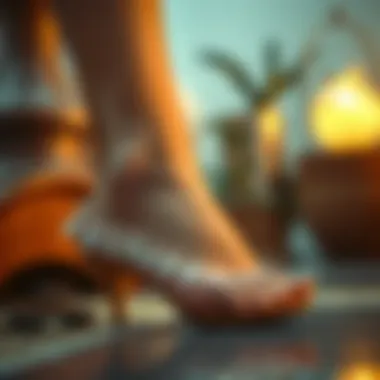

Ignoring heel care can cause cascading problems—what starts as a cosmetic concern can quickly escalate into something much more serious. Keeping one’s heel in tip-top shape is thus not just about vanity but about physical health too.
Aesthetic Concerns
Though some might consider an attractive foot a trivial matter, it holds significance in how one perceives themselves and how others perceive them. Dry, calloused heels can create an image of neglect. The aesthetic concerns about heel care encompass:
- Self-Confidence: Confident strides are often a reflection of well-groomed feet. When someone feels uncomfortable showing their heels, it can impact their self-esteem.
- Social Perceptions: In many situations, shoes come off. Be it at home or a beach outing; calloused heels might attract unwanted attention or comments.
- Fashion Limitations: Worn-out or calloused heels can limit one’s choice of footwear, pushing someone towards more conservative options that might not resonate with their personal style.
Ultimately, the way one's heels look can affect social interactions and self-image profoundly. People often underestimate the importance of small details, but when it comes to foot health, even the tiniest split can give rise to larger discussions about personal care and hygiene.
To maintain both comfort and appearance, consistent care for your heels is essential.
In summary, neglecting heel care can lead to a myriad of physical discomforts and aesthetic issues that can be easily mitigated through regular maintenance. Proper attention can keep not just the feet, but the individual's confidence, feeling buoyant.
Preventive Measures for Healthy Heels
Taking care of your heels is not just a matter of comfort; it's pivotal for your overall foot health. This section lays out preventive measures that can help maintain smooth, callous-free heels.
Choosing the Right Footwear
Choosing the proper shoes is one of the most crucial steps in preventing dry, calloused heels. Footwear goes beyond just aesthetics; it plays a significant role in providing the necessary support and comfort.
Support and Comfort
When it comes to footwear, support and comfort are paramount. Shoes that offer adequate arch support and cushioning can contribute hugely to foot health. They help evenly distribute weight, reducing pressure points that often lead to calluses. Often, shoes that are improperly fitted can create excess friction, which promotes the build-up of callouses. For instance, a well-structured pair of running shoes often feature gel or foam padding. This not only adds comfort but also minimizes the risk of heel cracking, a common issue among those who neglect proper shoe choices.
Key Characteristics of Support and Comfort
- Adequate cushioning that absorbs impact.
- Design that contours to the natural foot shape.
- Correct size to prevent slippage or pinching.
These characteristics make supportive footwear a popular choice among people who want to prevent heel issues while also remaining stylish. However, finding that perfect balance can sometimes be tricky, leading to either potential discomfort or aesthetic sacrifice.
Material Considerations
The materials used in your footwear can also make a significant difference. A good rule of thumb is to opt for breathable fabrics, like leather or canvas, as they allow airflow and reduce moisture retention. This can be particularly significant in hot weather when sweaty feet may lead to more significant problems.
Key Characteristics of Material Considerations
- Breathability: It helps in keeping feet dry and preventing fungal infections.
- Flexibility: Materials that allow your foot to move naturally can prevent discomfort.
- Durability: Strong materials can withstand wear and tear, ensuring they last longer.
Choosing the right material for footwear effectively reduces the chances of cracked heels and callouses. Plus, the long-lasting nature of quality materials can save you money in the long run.
Maintaining Hydration
Hydration contributes significantly to skin health. When the skin is well-hydrated, it becomes soft and resilient, reducing the likelihood of developing callouses.
Importance of Moisturizing
Moisturizing is not just a beauty tip; it’s an essential part of foot care. Regular application of moisturizers can prevent dryness, which is the leading cause of callus formation. Look for creams that contain urea or lactic acid, as these are effective in keeping your skin hydrated.
Key Characteristics of Importance of Moisturizing
- Hydration locks: Help to keep moisture locked into the skin, thus preventing cracks.
- Soothing properties: Can reduce irritation in the dry areas.
- Ease of application: Many ointments and creams are designed for easy application for regular use.
When applying moisturizers, focus on the heel area and use thick creams, especially before bed. This step ensures that your feet absorb the necessary moisture, helping to keep your heels supple and healthy.
Recommended Products
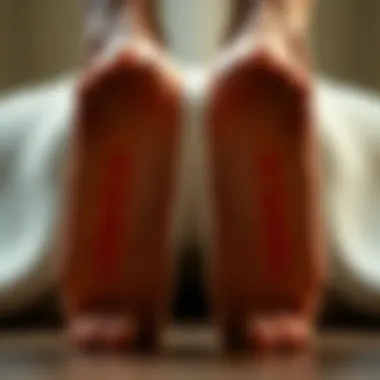

Looking into recommended products can make your moisturizing routine easier and more effective. Creams infused with natural oils like coconut or olive oil are often ideal for deep hydration without harsh chemicals. Brands like Eucerin or Burt's Bees have specialized foot creams designed to target dry skin effectively.
Key Characteristics of Recommended Products
- Natural ingredients: Reduce the risk of irritation.
- Fast-absorbing: Help you get back on your feet quickly.
- Specialized formulations: Specifically created for foot health, providing tailored care.
With the right products at hand, daily moisturizing can seamlessly blend into your routine. Ensuring that the foot care regimen is maintained, ultimately creates a solid foundation for shielding against heel dryness and callous formation.
Remember, creating a habit of caring for your feet does not just resolve existing issues; it sets the tone for a healthier future.
Effective Treatments for Calloused Heels
When it comes to the health and comfort of our feet, effective treatments for calloused heels are crucial. Dry, calloused skin can feel uncomfortable, lead to potential complications, and affect overall well-being. Therefore, knowing how to address this issue through effective techniques can make a significant difference for many.
Regular Exfoliation Techniques
Regular exfoliation is a fundamental step in treating calloused heels. It serves to remove the thick, dead skin that builds up over time, leading to smoother, softer feet. There are various ways to exfoliate, and what works for one person might not suit another. Here are a few methods to consider:
- Pumice Stones: A classic tool, pumice stones are great for gently sloughing away dead skin when used on damp feet. They help to reveal healthier skin beneath, gradually reducing callous buildup.
- Foot Scrubs: These can be found in many stores or made at home with simple ingredients like sugar or salt mixed with oil. They not only exfoliate but also nourish the skin, adding hydration in the process.
- Foot Files: Sometimes designed to be used dry or wet, these tools offer precision in tackling tough spots. Regular use can help maintain soft heels without excessive effort.
While exfoliation is beneficial, caution is advised to avoid skin irritation or over-exfoliation, which can lead to further issues. Balance is key here— getting a feel for how often and how intensely to exfoliate can take some trial and error.
Use of Foot Masks
Foot masks have gained popularity as a thorough treatment option for dry, calloused heels. They deliver intense hydration and nutrients, often allowing for skin renewal while you relax.
Ingredients to Look For
When choosing foot masks, it's important to pay attention to their ingredients.
- Urea: This is a standout ingredient known for its ability to retain moisture and help exfoliate dead skin cells. It's particularly beneficial for those with severe dry skin situations and aids in restoring softness.
- Shea Butter: Renowned for its moisturizing properties, shea butter helps to soothe and nourish the skin effectively. Its richness can penetrate deeply, making heels feel rejuvenated.
- Essential Oils: Ingredients like tea tree oil or peppermint oil can not only hydrate but also offer antiseptic properties, fighting bacteria that may arise from dry skin.
Selecting masks with these ingredients can markedly improve your foot care routine and is considered a beneficial option for many women seeking relief from calloused heels.
DIY Foot Masks
Creating your own foot mask is another practical choice that aligns well with personal care routines. DIY foot masks allow for customization based on what works best for one’s skin type or preference.
- Simple Foot Mask: Just mixing equal parts of coconut oil and honey can create a frequent use mask that immensely hydrates. The coconut oil locks in moisture, while honey acts as a natural humectant, pulling moisture from the air to skin.
- Natural Exfoliating Mask: A combination of oatmeal and yogurt can promote gentle exfoliation while offering soothing properties. The oats serve to scrub away dead skin, while yogurt promotes skin health with probiotics.
One significant advantage of DIY masks is the ability to utilize ingredients you might already have at home. This not only saves money but also ensures you're using natural products, minimizing the chance of adverse reactions. However, keep in mind that the results can vary, and while some may find success, others may need to explore different combinations to see effective results.
"An ounce of prevention is worth a pound of cure." Taking the time to treat and nourish your feet can lead to long-term benefits, establishing a solid foundation for healthy heels.
Addressing Underlying Health Issues
When it comes to taking care of dry, calloused heels, often the focus tends to be on external factors, such as creams, scrubs, and footwear. However, underlying health issues can significantly exacerbate foot problems, including any dryness and thickened skin. Recognizing these issues is paramount in adopting a more holistic approach to foot care.
Being proactive about these health concerns does not only improve the aesthetic and comfort levels of your feet but also aligns with general well-being. Some medical conditions can lead to the development of calluses and dryness, which can become worrisome if ignored. By identifying and addressing these root issues, individuals can pave the way for healthier skin and ultimately, a better quality of life.
Diabetes and Its Effects on Foot Health
Diabetes is a condition that has far-reaching implications for one's health, especially when it comes to foot care. High blood sugar levels can damage the nerves in the feet, leading to diabetic neuropathy. This condition often presents as numbness or tingling and can affect the body's ability to sense pain. As a result, many individuals with diabetes may not realize they have developed callouses or cracks on their heels until it is too late.
Additionally, diabetes reduces blood flow to the feet, slowing down the healing process of skin injuries. Poor circulation can lead to dry, cracked skin, making individuals particularly susceptible to infections. It is crucial for people with diabetes to regularly check their feet and practice good foot hygiene, emphasizing hydration and the use of appropriate foot care products.
Dermatological Conditions
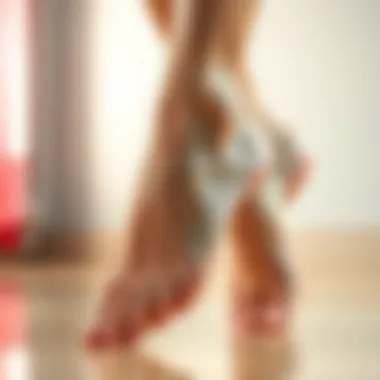

Eczema
One important dermatological condition that can impact the health of the feet is eczema. This inflammatory skin disorder can lead to patches of dry, itchy skin, which may worsen with scratches or irritation. Eczema often manifests in small, red bumps that could become thickened over time due to the skin's attempt to protect itself from continued irritation.
The key characteristic of eczema that makes it relevant to this discussion is the body's overactive response to irritants, making skin extremely sensitive. For individuals struggling with dry, calloused heels, addressing eczema could mean not only treating the callouses themselves but also finding ways to manage the underlying condition. Topical treatments that reduce inflammation and moisturizers designed specifically for eczema can be beneficial and should be thoroughly considered.
Psoriasis
Psoriasis is another dermatological concern affecting foot health. This chronic autoimmune condition causes the skin to regenerate at an accelerated rate, leading to thick, silvery scales that can cover patches of skin on the feet, including the heels. The unique feature of psoriasis is its unpredictability; flare-ups can be triggered by stress, infections, or even seasonal changes.
What makes psoriasis particularly challenging is the associated discomfort. Individuals may experience sensations of burning or itching, which can be difficult to manage. When discussing foot care and heel treatment, it's essential to recognize the implications of psoriasis as it directly affects the skin's barrier function, leading to greater susceptibility to dryness. Therefore, utilizing prescribed topical treatments and ensuring proper hydration is critical.
Lifestyle Adjustments for Sustainable Care
Addressing dry calloused heels requires more than quick fixes; it demands a shift in your daily practices and lifestyle choices. By adopting sustainable care habits, you can significantly improve the condition of your heels and enhance your overall foot health. The right adjustments allow the skin to not only recover but also fend off future dryness and callous buildup.
Incorporating Foot Care into Daily Routine
Integrating foot care into your daily routine may seem like a small thing, but its effects are profound. Just as you would dedicate time to skincare or oral hygiene, taking care of your feet should be no different.
Here are a few ways to fit foot care into your daily habits:
- Morning Routine: Start your day with a gentle exfoliation using a foot scrub or pumice stone. It doesn't take long and can dramatically influence how your heels feel and look.
- Evening Moisturizing: Before bed, apply a rich moisturizer or foot cream to your heels. Locking in moisture while you sleep allows your skin to rejuvenate overnight.
- Regular Foot Soaks: Incorporate warm foot baths with Epsom salts or essential oils into your weekly regimen. These not only soften the skin but also provide a relaxing experience.
Making these steps a habit will help keep dryness at bay and maintain healthy, comfortable heels.
Nutrition and Foot Health
Nutrition plays a vital role in the health of your skin, including that of your heels. The foods you consume directly impact your body’s ability to maintain hydration and promote skin repair.
Essential Vitamins and Minerals
Certain vitamins and minerals significantly contribute to your overall skin health. Here are a few key players to consider:
- Vitamin E: Known for its antioxidant properties, Vitamin E is essential for skin repair and moisture retention. It helps maintain elasticity and prevents the skin from drying out. Consuming nuts, seeds, and green leafy vegetables can boost your Vitamin E intake.
- Zinc: This mineral is crucial for skin health. It aids in skin repair and helps to regulate oil production. Foods like legumes, whole grains, and dark chocolate are rich sources of zinc.
The unique feature of these vitamins is their powerful roles in cellular repair, helping to combat the calloused and dry skin on your heels. When included in your daily diet, they can become a beneficial choice for achieving and maintaining healthy feet.
Hydration and Its Role
Hydration is often overlooked, yet it is one of the pillars of skin health, including your heels. Proper hydration supports skin elasticity and resilience. Here’s why hydration is so critical:
- Skin Moisture: When your body is well-hydrated, your skin can retain moisture better, lessening the chances of callouses forming. Aim for at least eight glasses of water a day to keep your system flushed and your skin well-hydrated.
- Healthy Blood Circulation: Good hydration promotes circulation, ensuring that vital nutrients reach the skin and support its overall health.
By prioritizing hydration, you not only substantiate your foot health but also promote a range of other bodily functions. The advantages of staying hydrated cannot be overstated—it’s a simple yet effective way to enhance the health of your skin and specifically target issues like dryness and callouses.
In summary, making lifestyle adjustments is essential for sustainable heel care. By incorporating foot care practices into your daily routine and paying attention to nutrition, you set the stage for healthier, more resilient heels.
The End
Caring for our feet may not be at the forefront of many people's minds, yet the need to address dry calloused heels is not to be underestimated. In this article, we've delved deeply into the myriad ways individuals can enhance their foot health through awareness, preventive measures, and targeted treatments.
Summary of Key Points
- Understanding Anatomy: Recognizing that the heel structure plays a vital role in our walking and overall comfort can shift one's focus to proper care techniques.
- Identifying Contributions: Various factors such as harsh environment conditions, unsuitable footwear, and underlying health issues necessitate an informed approach to heel care.
- Preventive Measures: The choices made in daily routines, from the type of shoes worn to the importance of moisturization, serve as the bedrock of prevention.
- Treatment Techniques: Regular exfoliation and the use of foot masks can drastically improve skin health, making heels feel soft and smooth.
- Addressing Health Conditions: Ignoring health problems can have dire repercussions on foot health; being proactive is key.
- Lifestyle Adjustments: Integrating foot care into daily practice and understanding the influence of nutrition can lay a strong foundation for long-term heel health.
"An ounce of prevention is worth a pound of cure."
By weaving these elements together, a comprehensive blueprint for foot health emerges, allowing individuals to take control over a common yet often trivialized aspect of personal care.
Call to Action
It's high time to prioritize foot health. Start incorporating the tips outlined in this article into your routine. Whether you're re-evaluating your footwear choices or diligently moisturizing your heels, small changes can lead to significant improvements. Don’t let dry calloused heels dictate your comfort. Embrace a proactive approach to self-care. If you suspect underlying health issues, consult a professional to stave off more serious complications. Your feet carry you through life; ensure they are well cared for, and they will serve you well for years to come. Explore more on maintaining foot health by visiting CDC Foot Health or consult detailed articles on PubMed for comprehensive health information. Let today be the day you step toward healthier feet!






